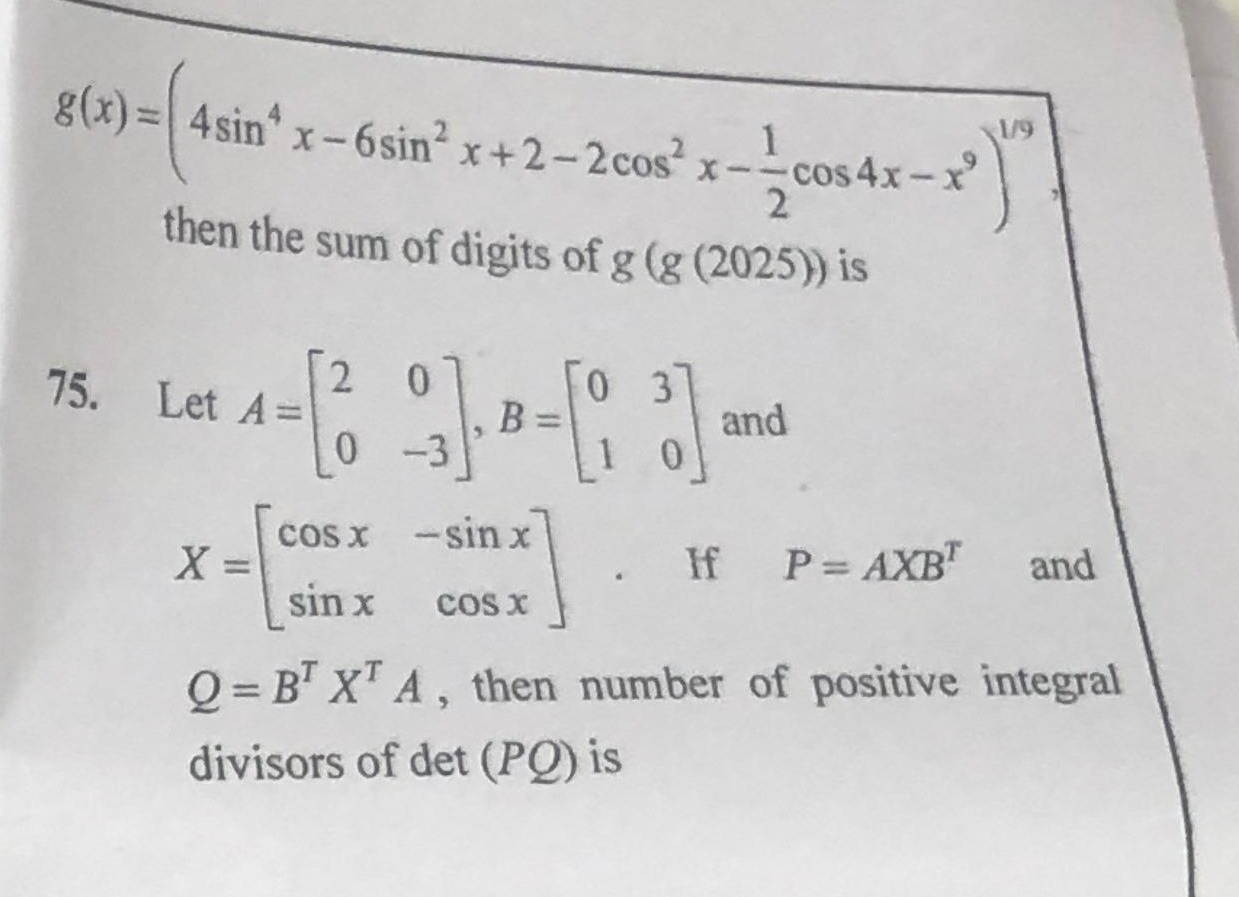Question
Question: Let the expression inside the 9th root be $E$. $E = 4\sin^4x-6\sin^2x+2-2\cos^2x-\frac{1}{2}\cos4x-x...
Let the expression inside the 9th root be E. E=4sin4x−6sin2x+2−2cos2x−21cos4x−x9 Using trigonometric identities: cos2x=1−sin2x sin2x=21−cos2x cos4x=2cos22x−1
Substitute cos2x=1−sin2x into E: E=4sin4x−6sin2x+2−2(1−sin2x)−21cos4x−x9 E=4sin4x−4sin2x−21cos4x−x9
Substitute sin2x=21−cos2x and cos4x=2cos22x−1: 4sin4x=4(21−cos2x)2=1−2cos2x+cos22x 4sin2x=4(21−cos2x)=2−2cos2x
Substitute these into E: E=(1−2cos2x+cos22x)−(2−2cos2x)−21(2cos22x−1)−x9 E=1−2cos2x+cos22x−2+2cos2x−cos22x+21−x9 E=(1−2+21)+(−2cos2x+2cos2x)+(cos22x−cos22x)−x9 E=−21−x9
Thus, the function simplifies to g(x)=(−21−x9)1/9.
Let y=g(2025). Then y=(−21−20259)1/9, which implies y9=−21−20259. Now, we evaluate g(g(2025))=g(y): g(y)=(−21−y9)1/9 Substitute the expression for y9: g(y)=(−21−(−21−20259))1/9 g(y)=(−21+21+20259)1/9 g(y)=(20259)1/9=2025.
The sum of digits of g(g(2025)) is the sum of digits of 2025. Sum of digits = 2+0+2+5=9.
- Let A=[200−3], B=[0130] and
X=[cosxsinx−sinxcosx]. If P=AXBT and
Q=BTXTA, then number of positive integral divisors of det (PQ) is

9
15
24
30
The question contains two independent problems. The first problem asks for the sum of the digits of g(g(2025)), which is 9. The second problem asks for the number of positive integral divisors of det(PQ), which is 15.
Solution
Problem 1: The function g(x) simplifies to g(x)=(−21−x9)1/9. Evaluating g(g(2025)) results in 2025. The sum of the digits of 2025 is 2+0+2+5=9.
Problem 2: Given matrices A=[200−3], B=[0130], and X=[cosxsinx−sinxcosx]. det(A)=−6 det(B)=−3 det(X)=1
P=AXBT⟹det(P)=det(A)det(X)det(BT)=(−6)(1)(−3)=18. Q=BTXTA⟹det(Q)=det(BT)det(XT)det(A)=(−3)(1)(−6)=18.
det(PQ)=det(P)det(Q)=18×18=182. The prime factorization of 18 is 2×32. So, 182=(2×32)2=22×34. The number of positive integral divisors is (2+1)(4+1)=3×5=15.
